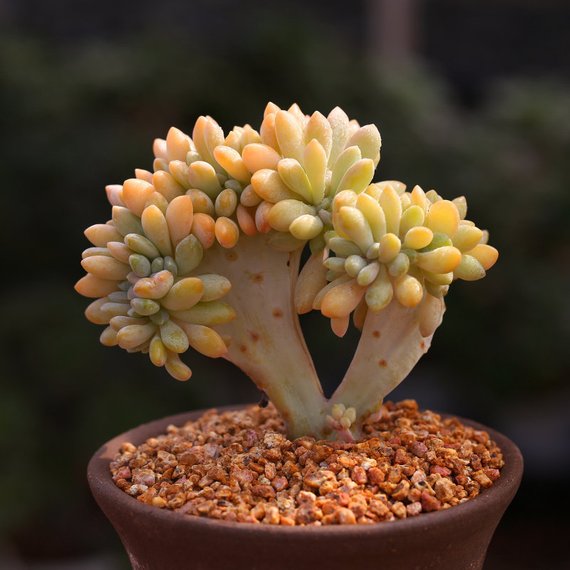The stem is upright, fan-shaped, semi-woody, with fleshy, thick, plump leaves that are spoon-shaped, elongated oval, and covered in white powder.
Habitat: Prefers warm, dry, and sunny environments, tolerant to drought but sensitive to waterlogging. Thrives in loose, fertile soil with good drainage and coarse particle size.
Mature Size: Small.
Leaf Shape: Spoon-shaped, elongated oval, covered in white powder.
Appearance: Subject to changes due to season, light exposure, and temperature fluctuations.
Sunlight: Can be exposed to sunlight in spring and autumn for better coloration; when leaves are plump, outdoor cultivation is possible.
Soil: Initially, a mixture of peat soil and perlite can be used, with later use of soil with a higher proportion of coarse particles.
Temperature: Suitable temperature range between 10 to 30°C.
Propagation: Leaf cuttings, beheading, division.
Pests: Aphids, red spider mites, scale insects, snails, etc.
Suitable Planting Locations: Balcony, windowsill, terrace.
The leaves of Graptopetalum amethystinum 'cristata' are very small, roughly the size of soybeans. However, the plant produces numerous leaves, with a single plant yielding hundreds. The leaves are round and plump, exceptionally glossy, with a layer of white powder on the surface. Initially greenish, they turn orange-red under the influence of light and temperature fluctuations, resembling tiny grapes, with a nearly transparent texture, giving them a particularly endearing appearance.
Potting Soil: Although Graptopetalum amethystinum 'cristata' plants and their leaves are small, they grow vigorously. Therefore, a slightly larger flower pot is recommended. The soil mix should include peat soil, which is fertile and loose, promoting plant growth and stem lignification. Additionally, perlite and river sand can be added for excellent drainage and aeration, allowing the roots to penetrate deeper without concerns of waterlogging or soil compaction. Before potting, organic fertilizer should be spread at the bottom of the pot for long-term nourishment. A 1:1 mixture of perlite and peat soil should be sterilized before use.
In addition to soil nutrients, photosynthesis is crucial for the growth of Graptopetalum amethystinum 'cristata'. During the growing season in spring and autumn, it should be placed in direct sunlight for full, plump leaves. Outdoor cultivation benefits from the combined effects of light and temperature fluctuations, resulting in a cute, plump appearance. During hot summers, partial shade is advisable to prevent sunburn. In cold winters, when outdoor temperatures drop significantly, it's best to place the plant in a well-lit indoor area to enhance its cold resistance.
Each leaf of Graptopetalum amethystinum 'cristata' contains a lot of water, making it highly drought-tolerant. It prefers dry conditions and generally requires minimal watering. During the growing season, water thoroughly when the soil dries out, approximately every 10-15 days. In summer, when the plant enters dormancy and its water absorption decreases, less frequent watering is needed. However, in extremely hot conditions, water should be applied sparingly every two weeks to prevent dehydration. In winter, watering should be minimized to once every 20 days, and watering should be stopped when indoor temperatures drop to freezing to prevent frost damage to the plant.
